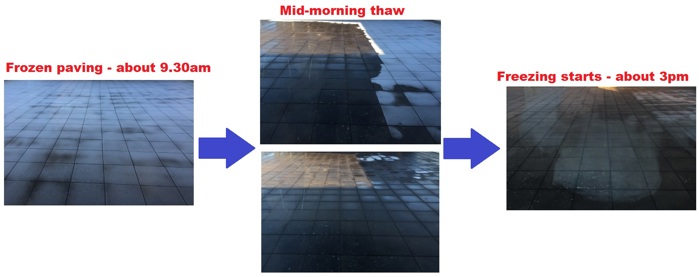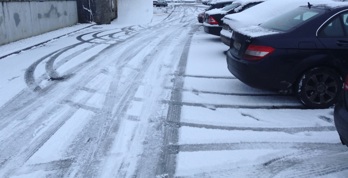Locations Safeguards for Ice (/Snow) Slips and Falls
Identify and deal with high-risk areas. Use the Mapping tool to help identify high-risk areas
Many accidents involved walkways and carparks
Walkways
- Provide clearly marked safe walkways
- Divert pedestrians to less slippery walkways
- Provide a slip resistant surface - grit or salt may help
- Use warning signs as required - consider smart signs that warn of changing conditions
- Cordon off hazardous areas/walkways
- Identify and take precautions at walkways where the ground may not thaw
- Consider shade patterns, cloud cover, direct sunlight, air temperature

- Monitor weather forecasts for freezing conditions and weather warnings
- Identify and take precautions at level changes, bodies of water that workers may try to walk on
Car parks
- Provide clearly marked safe walkways
- Ensure proper precautions (clearing, salting, gritting) before pedestrians use the car park
- Communicate precautions when exiting vehicles - "Open the door, Check the floor"
- Ensure the car park is properly maintained, e.g. no potholes, no areas where puddles form, a sufficient slope and drains
- Highlight kerbs or other hazards under snow
- Ensure adequate lighting
- Reduce and signpost reduced speed limits as required
- Consider smart signs that warn of changing conditions

Entrances
The safest approach may be to ensure the floor areas inside and outside the entrance are slip resistant when wet
- Implement a wet weather protocol as needed
- Provide clearly marked safe walkways
- Deal with moisture that may be brought into buildings on umbrellas, raincoats, e.g. umbrella stores / covers
- Have procedures to remove ice, snow, sleet from footwear, clothing, umbrellas
- Provide drains, additional mats at entrances
- Provide additional staff to monitor entrances at peak times
Third-party premises
- Implement Dynamic Site-Specific Risk Assessments
- Empower workers to be responsible for their own safety
- Have a general rule that workers don't walk on ice unless they can do so safely
- Consider communicating with those responsible for work premises
- Dairy UK Guidance (August 2015) noted a company reduced delivery slip and trip accidents with a new LED cap with hands-free light in the brim
Ice slips can be an important part of Slip Risk Assessment and Prevention
A risk assessment approach to Ice and Snow slips (trips and falls) should consider
